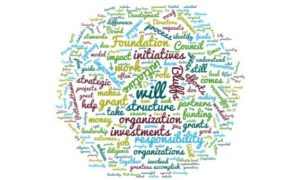

“With great power comes great responsibility.” This adage comes to mind because I was recently asked: “Isn’t your job just to give away money?” Well, yes and no. Yes, our primary “job,” is to award funding three times per year. But along with that comes the responsibility to be good stewards of our investments all year long. We have an obligation to the community to ensure our funding makes a significant difference now and for future generations.
To achieve that goal, our strategic plan called for us to take a more deliberate approach. To accomplish that we have recognized the importance of convening partners to gather input on what investments will have the biggest impact for all of us. We identify those efforts as “initiatives” and sometimes take the leadership role in implementation. Other times, another organization takes the lead.
Our work at the Mid-America Center, the Riverfront, and Pottawattamie Promise are all examples of initiative efforts in which we are heavily involved in the leadership. There are other efforts, such as the BLink Wi-Fi project, in which we are intimately involved but don’t take the lead role. For the past year, we’ve been educating the community and our stakeholders about the differences between such initiatives and grants. According to our website poll, a majority of our respondents still don’t fully understand the concept. This is most likely because the Foundation has traditionally served in a reactive role versus being the proactive driver of projects.
In the old model, organizations submitted grant requests and we only responded with a yes or no. In the new model, in addition to awarding grants, we join with partners to determine what is important. You can read the full Leadership Notes blog post about the similarities and differences between grants and initiatives here, but it’s important to know that initiatives, which often involve large catalytic projects, have emerged as one focus for the Foundation.
An example of this at work includes the recent Community Development initiative. This initiative brought together five agencies (Pottawattamie County Development Corporation, Bluffs Downtown, Live Well Council Bluffs, Habitat for Humanity of Council Bluffs and the Council Bluffs Housing Trust Fund). All of these organizations have been long-time grantees. Many had expressed frustration at not having an adequate structure which would allow them to achieve their goals. Because the executive director often had to serve as a program officer, accountant, social media specialist and fundraiser, these organizations were struggling to have the impact the organization was set up to do. The newly combined organization will provide an organizational structure that will create a combined larger staff to serve in more suitable roles. As a strategic leader, we brought together the partners and helped guide the process of developing this new structure, which is what will help make the organization successful. And for less money.
That said, we still have a strong grant making program. Organizations still apply and our Board of Directors makes decisions about funding those requests. To better align our grant making with our desire to increase the impact of our investments, we’ve instituted a more thorough due diligence process, which involves questions on the short and long-term outcomes sought by grantees. We know nonprofits and government entities do important, meaningful work, but we seek to understand if and how it makes the difference we all intend it to. It would be easier (and everyone would be happy) if we awarded each grantee that applies with the funds they request. The reality is that we have limited funds and a responsibility to invest our resources in a manner that will result in the outcomes we seek. That’s why we go through the due diligence process and conduct periodic evaluations. If the right formula is in place, the money will help accomplish the mission.
Our community-based strategic plan helps guide us in both our grant and initiative investments. Our task forces help us to identify the focus of the work. Our advisory committees and the Board of Directors are engaged in oversight and approval. This is the structure we using to ensure our responsibility to be good stewards of the Foundation’s resources. After all, it’s our “job.”

